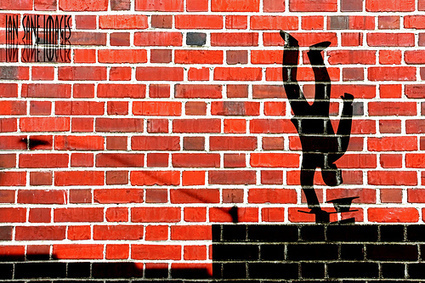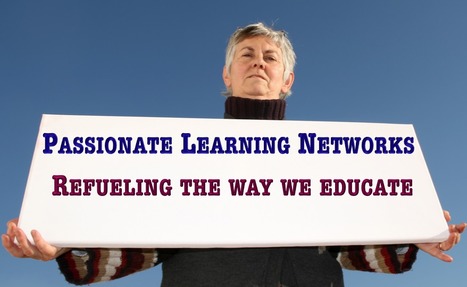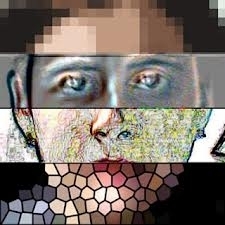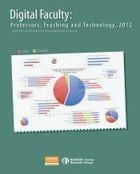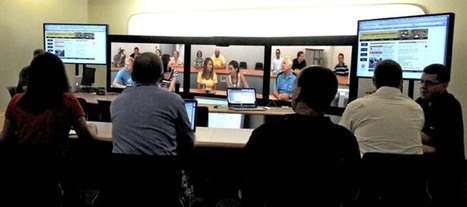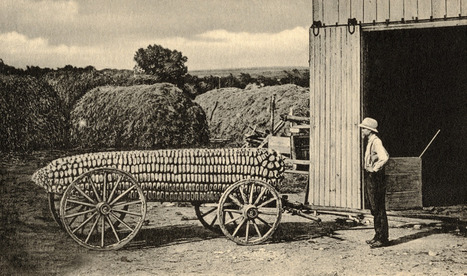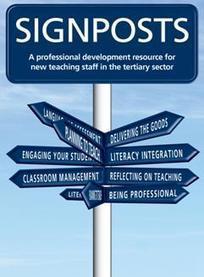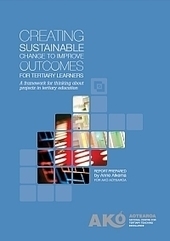What exactly does it mean to flip a classroom? The idea means reversing the standard order of learning that involved students sitting for instruction in the class and then doing homework outside of class.
Get Started for FREE
Sign up with Facebook Sign up with X
I don't have a Facebook or a X account

 Your new post is loading... Your new post is loading...
 Your new post is loading... Your new post is loading...
Zoran Popovic is the Director of the Center for Game Science and a professor at the University of Washington.
For the past year, I have researched the what, who, when, how, and why of Personal/Professional/Passionate Learning Networks (PLNs). We have seen the benefits of the people we choose to connect, collaborate, and problem solve with through social media. The educators, subject matter experts (SMEs), authors, and mentors we choose to derive knowledge from help us self-reflect on our methodologies and beliefs.
Feeding Forward the role of the participatory web in formative assessment http://www.flickr.com/photos/99771506@N00/5791228... Via Mark Smithers, Kim Flintoff
Today, most educational systems are designed to work from the microscopic to the macroscopic. Students learn facts and figures and tiny fractions of knowledge long before anyone really puts things into a larger context.
KF: And therein lies the argument for authenticity and student-centred strategies for learning. Via Dr. Susan Bainbridge
Professors occasionally get lampooned as luddites responsible for the famously slow pace of change in higher education. But in truth the majority of professors are excited about various technology-driven trends in higher education, including the growth of e-textbooks and digital library collections, the increased use of data monitoring as a way to track student performance along with their own, and the increasingly popular idea of “flipping the classroom.”
Bill Ferriter is a 6th-grade language arts teacher in North Carolina, and in an effort to integrate technology into his curriculum, he set up a blog for his students and invited them to contribute. Two months went by and Ferriter didn’t see a single post, despite passionate encouragement and pleading. His “grand blogging experiment” died before it ever really began.
A series of short guides for assisting the professional development of new lecturers/tutors.
You are welcome to use and adapt these guides as long as you attribute Weltec and Ako Aotearoa as per the following Creative Commons copyright statement:
This work is published under the Creative Commons 3.0 New Zealand Attribution Non-commercial Share Alike Licence (BY-NC-SA). Under this licence you are free to copy, distribute, display and perform the work as well as to remix, tweak, and build upon this work noncommercially, as long as you credit the author/s and license your new creations under the identical terms.
Australian universities need to be able to choose where they wish to place themselves on the continuum between teaching and research, between transmitting known knowledge and discovering the unknown, between short-term applied and long-term basic research, between cultivating students’ character and deepening their specific expertise, as well as between building international scholarly reputation and building national identity, between serving the professions as they exist and changing their social shape, between partnering with the community and standing apart as its independent critic.
RISING competition for students is putting a greater focus on teaching quality, with many universities looking to improve evaluation surveys and boost professional development and recognition for teaching.
NEW academic standards will give special emphasis to learning outcomes.
Ako Aotearoa’s vision is the best possible educational outcomes for all learners. Achieving this vision has many dimensions, but a critical part is to develop more effective teaching and learning. This is an increasing challenge when, on the one hand, we are operating in times of inevitable resource constraints and on the other we are continually being urged to engage with new social and learning technologies to extend our practice.Immediately this raises a question: “how do we know what is effective practice?” How do we test our assumptions about what is working for our learners and what is not? On the surface this is an obvious and fundamental question, but across the sector we have been surprised at the relatively small number of practitioners who systematically gather and use evidence of how learners do or do not benefit from different approaches to teaching.
An unwritten law has emerged in both the sciences and social sciences – that it is better to measure than not to measure. |
A handful of classrooms in Anoka-Hennepin high schools might appear equipped for surveillance rather than teaching to students returning from summer vacation next week.
KF: This strategy has a lot to offer educational instiitutions that may find they have unsustainable course offerings dur to flagging enrolments. Creating partnerships that allow cohorts to connect via telepresence may mean that a viable class can be established as a cross-institutional undertaking.
Higher education is rapidly changing - you don’t have to even be paying much attention to see that. Via pru
School systems today need leaders who are technologically savvy and can navigate the online environment. They must also have skills ranging from financial and human resource management to outcomes measurement, and government relations-all with a solid grounding in ethics and personal conviction. Some educational leaders are concerned that the online environment does not have the same high quality as the campus environment, but comparing campus and online classes may be like comparing apples and oranges because there are differences in the type and caliber of learners who choose one delivery model over the other, and there are differences in personality and communication skills of campus instructors and online instructors. After careful consideration of the potential benefits and challenges of the e-learning paradigm, it is reasonable to conclude that when it is done well, e-learning can be authentic and active. Quality online programs and global partnerships enable best practices institutions to develop professional adult educators and invest in faculty development of scholar-practitioners.
Stanford University announced the creation of an Office of the Vice Provost for Online Learning today, appointing computer science professor John Mitchell as the office’s inaugural head.
What happens when you teach students how to lie?
But something else happens in this class that I have only rarely seen in 16 years of university history teaching: my students laugh their way through the entire semester.
KF: This report reflects what it means to flip your classroom. The pedagogical shift that occurs when this teacher asks his students to embark on a journey - to do something they are not certain about - is exactly what a student-centred model might suggest. It is also a fine example of action learning on behalf of the teacher... unless of ourse its all fabricated as well! ;-)
The pressure is on.More and more universities and academics are working in a culture that is untenable and cracks in the ivory tower have already begun to appear.The work environment is now characterised…...
"In the past, metrics of quantity allowed us to assess the performance of researchers, but now they have become an end in their own right. Ironically, once people deliberately pursue key indicators of performance, these indicators become less useful as independent yardsticks of what they were originally designed to measure."
This guide for new tertiary teachers is a series of one-page 'Signposts' explaining key ideas of teaching and learning. It is the result of a project funded by the Ako Aotearoa Northern Hub.
UPDATE - Following a collaborative national evaluation of Signposts, version 2 of Signposts is now available.
In addition, based on information from this evaluation, the project team has developed a Tertiary Teaching Staff Developers' guide to suggested uses of Signposts.
A LACK of diversity among Australian universities is affecting the student experience as universities, shackled by booming enrolments and high research costs, struggle to meet the basic demands of quality teaching, says the new vice-chancellor of...
UNIVERSITIES face declining student demand in the face of online competitors which will erode income according to Warren Bebbington, the University of Adelaide's new vice-chancellor.
This publication assists project teams to plan and implement tertiary teaching and learning projects that bring about change in teaching practice.
This short publication is designed to help prospective project teams interested in improving teaching and learning scope out what this means in terms of project planning and implementation.
Our experience to date tells us that achieving sustainable change through projects requires careful planning and ongoing effort. The life of a project often extends beyond the funded timeframe of ‘doing the work’ and includes both socialising of ideas within organisations, as well as ongoing promotion and implementation of the work once completed. Successful project teams clearly communicate the relevance of the work to gain buy-in, and link well with existing networks to gather momentum and excitement for the work as it develops.
Critically, the successful impact of a project depends on a clear demonstration of learner benefit. There are, of course, no one-size fits all approaches here. This guide is designed to assist in formulating questions and approaches in the particular context of the project. We trust it will be useful for those charged with leading organisational development in terms of teaching and learning. The publication is also designed to assist individuals and teams developing grant applications for project funding.
This publication is related to A tertiary practitioner's guide to collecting evidence of learner benefit, which was also prepared by Anne Alkema to provide an introduction to the process of collecting evidence of learner benefit.
The Centre for Adult Education and Community Outreach (CAECO) in the Faculty of Education at Brock University in St. Catharines offers part-time programs leading to a Bachelor of Education in Adult Education and a Certificate in Adult Education. |



